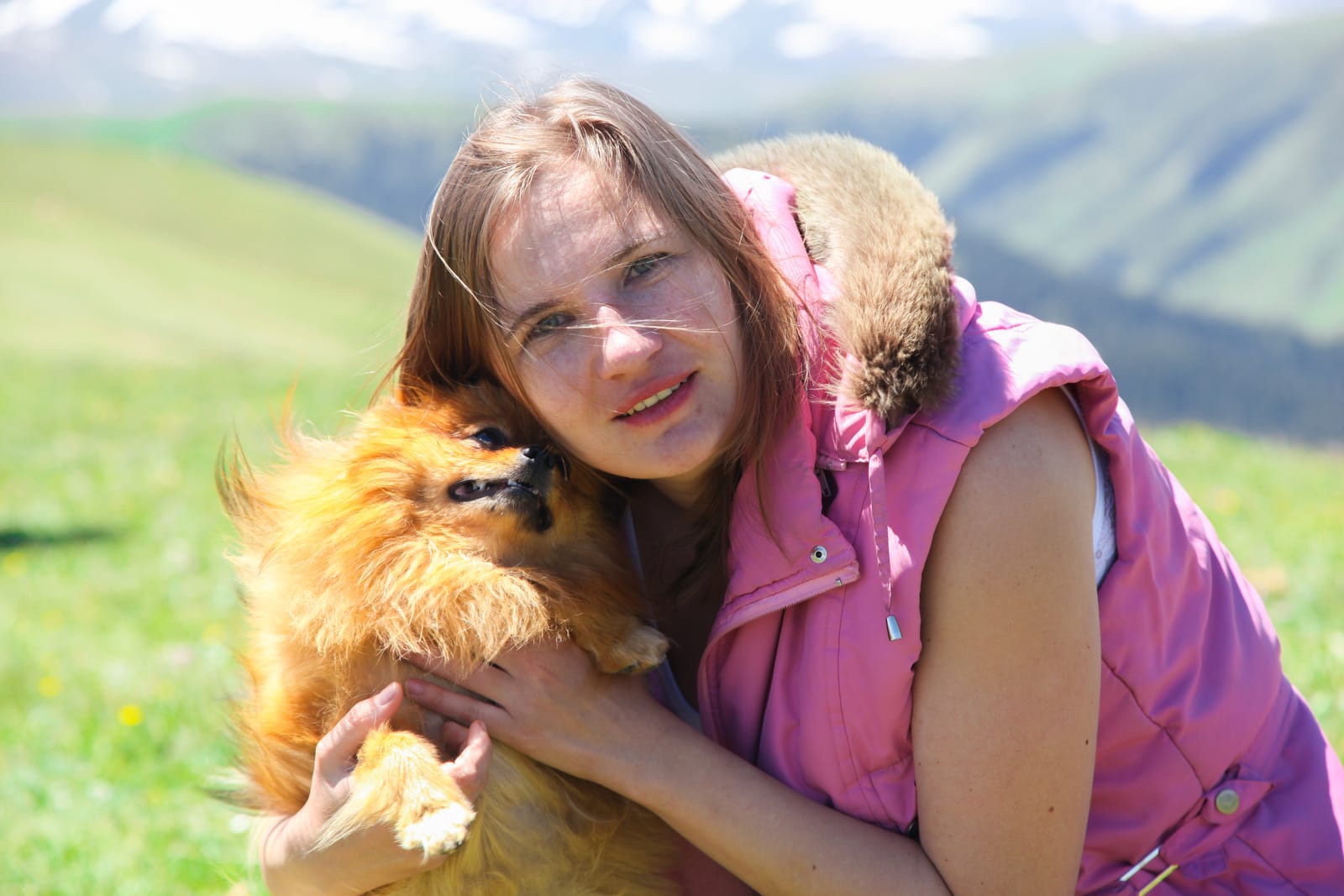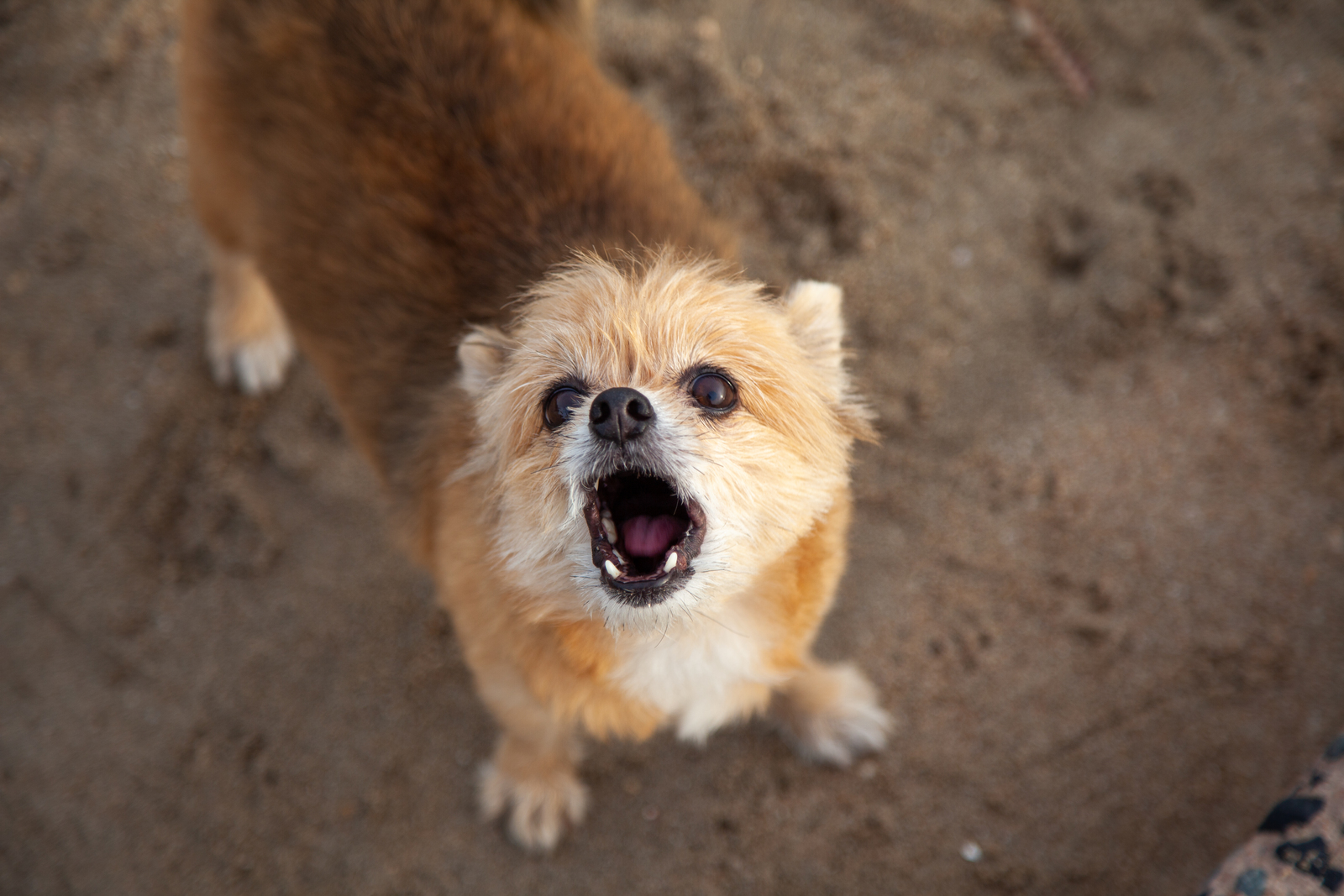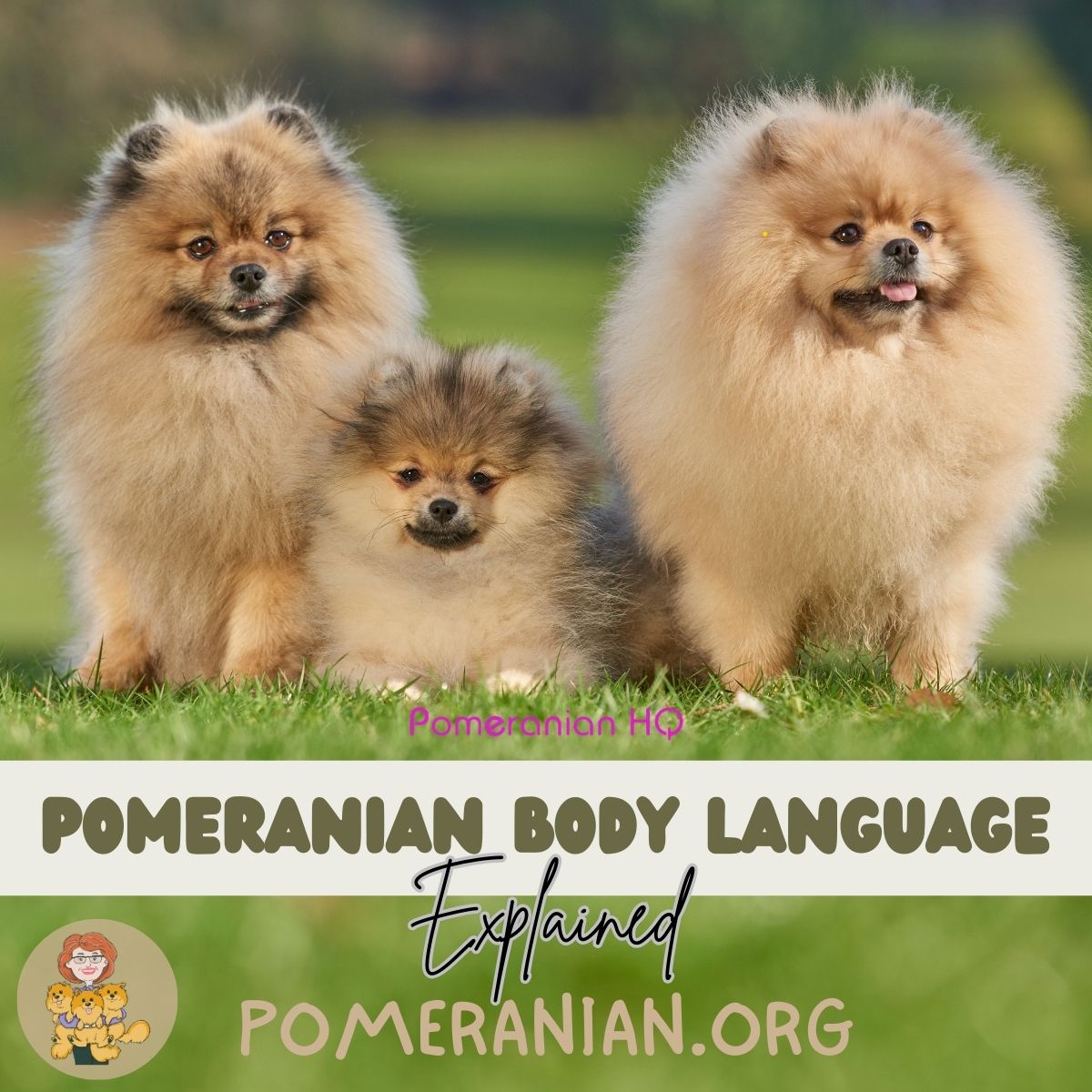Last Updated on 25/04/2024 by Denise Leo. Post first published on April 24, 2024.
Understanding the body language of your Pomeranian can greatly enhance your relationship and communication with this fluffy family member. Pomeranian body language is a fascinating mix of signals and expressions that convey their emotional state and intentions to their owners. As pet parents, learning to read these cues is among the best ways to ensure your Pomeranian feels understood and is a happy dog.
A wagging tail, for instance, is one of the most recognized forms of dog body language. However, the meaning behind the wag can vary; slow wags might suggest insecurity, while rapid tail wags that involve the entire body generally indicate excitement or happiness.
Observing the position of your dog’s ears and tail can provide further clues about their feelings. Ears perked up can mean your Pomeranian is on high alert, possibly due to unfamiliar dogs or sounds, whereas a relaxed dog might have their ears in a more natural position, slightly to the side.
Another aspect to watch is the play bow—front paws stretched forward, back legs standing, and tail up. This is a dog’s way of saying they are in a playful mood and not a threat. Conversely, signs of stress or fear in Pomeranians might include a tucked tail, a direct stare, or even a submissive grin, which exposes the front teeth as an appeasement gesture.
Senior and adult dogs, who may have health problems, could show different body language than younger dogs, such as less enthusiasm in their tail wags or a more subdued general demeanor. Understanding these subtle differences in canine body language can help dog owners prevent unwanted behaviors and address signs of aggression or fear early on.
Through positive reinforcement and attentive observation, pet parents can learn the basics of dog body language to better understand and cater to their Pomeranian’s needs, making them feel like cherished and well-understood family members.
Most people confuse their dogs because they change their vocal and visual cues. The same visual cues could mean different things. Words can be used in varying contexts, so it’s hardly surprising that dogs don’t go crazy trying to interpret what their owners want.
However, dogs are intelligent (for the most part), so they can figure out what you’re trying to tell them. Make it easier for your dog to know what you want, and he’ll love you for it.

Pomeranian Body Language
The trouble with using body language is that what a human may think something means differs from how a dog interprets it. Here are some guidelines to help with better communication:
Never stare at your Pom. He thinks that’s a threat, and if he’s about to bite, he may attack in what he sees as self-defense. Staring can also scare a dog to the point where he pees on himself or runs away to hide. You can look at a point near him but not directly at him.
Protect your Pomeranian from strangers who may approach him quickly. When strange dogs first meet, they tend to creep up sideways in a circular move so they can suss each other out. If a dog doesn’t do this, it sends a message that they may attack.
If a person does this, they feel threatened. The dog may react in three ways: try to escape, hunker down, or bite in self-defense. If your pet is scared, stroll up to him and stop with your side towards him.
If somebody wants to pet him, tell them to scratch under his chin. Patting on the back or head is regarded as being dominant. A dominant dog would do that to one that’s submissive. If you have a submissive dog, scratching under his chin is the best way and he’ll also like it.
If you want your dog to follow you, turn your back on him and walk while calling his name. To make him stop, face him (making you seem big) and take one or two steps in his direction. A dog views you walking towards him as a message to follow in that direction while keeping out of your way. A dominant wolf behaves this way when leading his pack.
It’s common for a person to call a dog while facing him…and then get annoyed when the dog walks away. He’s only doing what you told him to do. Don’t hug your pet. Dogs don’t hug each other.
The only similar behavior is when they hump, and the one on the bottom doesn’t like it. So he sees a hug as being dominant and tries to squirm out of it.

Give Verbal Commands Correctly
It’s normal to talk to your dog, but it would be odd if you didn’t. However, your constant babbling may be confusing. Also, as he turns his head and seems to listen, he’s only trying to hear words that mean something to him, such as eat, walk, food, treats, etc. How you talk to your dog is as vital as what you say.
Your volume, tone, and language are all key elements, so remember these points to be an effective communicator:
Choose a single word for each command and then stick with that word. If you want your Pom to come to you when you call, say “come.” Don’t use variations such as come here, here, boy, over here, and various other options.
Choose one word and only use that word, even in training, until he obeys you easily. Choose unique words. Don’t use similar words for multiple commands, or your dog will get confused. If your pet’s name is Sid, don’t use “sit” because confusing the two is easy.
Some people use a foreign language, which makes it a bit fun. It would be best if you were consistent with the sound of the command and the word itself. Dogs are more in tune with sounds, so keep your voice steady.
Never yell because he has much sharper hearing than you do. Yelling may frighten him (unless he’s far from you, perhaps off his leash in a dog park). If you want to tell him off for something, use a low tone because it indicates leadership, aggression, and power.
Most species use low tones, often as threats. They make the animal being scolded stop and listen. If your dog is about to run into the path of a car, the word STOP! in a low but loud tone will make him stop dead in his tracks.
A high-pitched tone denotes playfulness. The dog will feel happy and ready to play. People speak to dogs much like they do to babies because it’s not threatening, and it’s easy to ignore if the pet or baby is stubborn.
Think about the rhythm of what you say. It’s natural for people to alter their cadence to get the response they desire.
These are just a few examples:
- An abrupt, low tone will stop your dog from doing whatever he’s doing.
- A set of short, high-pitched, repeated sounds that keep rising higher in pitch usually makes your dog go faster.
- • A monotonous, long talk calms or slows your pet down.
If you want him to come running to you, say “go, go, go, go, go, go in short bursts. Once he is there, say noooo in a low tone to stop him. Then draw out the words “settle down” to calm him.

Learn to Understand Your Pomeranian
While you teach your dog how to understand you, it’s also essential that you put effort into learning what he means by the different things he does and the sounds he makes. He doesn’t speak English so you have to be smarter when working out his meaning.
Learn Pomeranian Body Language
Take your time and learn properly. Observe your dog doing all the things he normally does. Watch how other dogs behave as well. Then, watch how your dog interacts with other dogs. You’ll quickly notice numerous facial expressions and body language.
Piecing it all together will take time, but it’s time well spent because your bond will grow stronger as you learn more about communicating with your beloved pet.
Eventually, it will all become second nature. Listening is another aspect, but I’ll cover that shortly.
The Language of Pomeranians
Every movement has a meaning, so get to know these:
• Leans forward: interest and confidence.
• Stands with stiff legs while leaning forward: aggression or dominance.
• Leaning backward: Submission or fear.
• Lowering his head or crouching down: submission, anxiety, or fear.
• Lowering the body, twisting his head to one side, especially if he’s crouching: submission.
• Lowering his front end until his elbows touch the floor while his butt is waving in the air: he’s feeling playful.
• Rolls onto his back: depending on the situation, this may be fear or submission…or simply that he wants a tummy rub.
• Rolls around while lying on his back: He’s having fun!
• Putting his head or a paw on the back of another dog: trying to dominate.
• Slams into another dog with his hip or body: playfully dominant.
• Turning his head away: truce or submission.
• Head held high: Perhaps challenging another dog. Make him turn away before trouble starts.
What’s Your Pom Saying?
Dogs don’t just bark. They also howl, growl, hum, pant, yip, whine and sneeze. Each sound has a different meaning. New owners are often worried if their dog growls like a tiger.
However, that’s just part of their language and can mean different things. When he growls, don’t scold him. Listen to see if you can decipher what he’s saying.
Interpreting Your Pomeranian’s Language
- A yip or single brief bark: he’s demanding something.
- He may want food, to play, to go for a walk, or something else.
- One low-pitched bark: stay away from him.
- A single low-pitched bark, a warning to stay away.
- Staccato barks: intruder alarm.
- Repeated yipping: he’s excited.
- One soft bark: he wants you to play with him, or it’s an uncertain warning.
- A low growl warns another subordinate dog to stay away. That’s ok, but not if he growls at you.
- A low growl combined with some yips could also warn an equal to go away, but it’s unacceptable if he’s doing it to you.
- An undulating, high-pitched growl: uncertainly or fear.
- High-pitched growls that are short and often repeated: Let’s play.
Pomeranian Body Language Conclusion
In conclusion, decoding your Pomeranian’s body language offers invaluable insights into their emotional and physical well-being. Each tail wags, ear position, and eye expression communicates something vital about your dog’s feelings and health. Recognizing these signals, from a playful dog’s relaxed posture to a fearful dog’s tucked tail or hard eyes, is crucial for any pet parent.
Paying close attention to these dog body language signals—like the softening of facial muscles or the neutral position of the tail—can help you understand what your dog feels and alert you to potential medical conditions or signs of stress. For instance, a dog that keeps its tail between its legs or displays aggressive body language might indicate health issues or discomfort in its environment.
Understanding the language of your Pomeranian’s body is the most important thing you can do to ensure their happiness and safety. It’s also a good example of how dogs express their unique personality traits and needs. The next time you observe your dog, take note of their overall body posture, the position of their front legs, or even the intensity of their bark. These are among the biggest indicators of your dog’s emotions and a sure sign of how they’re coping with their surroundings.
By maintaining a safe environment and being alert to changes in body language, you can create a nurturing space where your Pomeranian feels secure and loved. Remember, each dog is different, and keeping a close eye on these subtle cues will help you respond better to their needs, ensuring a healthy and happy life together.
Senior and adult dogs, who may have health problems, could show different body language than younger dogs, such as less enthusiasm in their tail wags or a more subdued general demeanor. Understanding these subtle differences in canine body language can help dog owners prevent unwanted behaviors and address signs of aggression or fear early on.
Through positive reinforcement and attentive observation, pet parents can learn the basics of dog body language to understand better and cater to their Pomeranian’s needs, making them feel like cherished and well-understood family members.
Copyright Pomeranian.Org. All Rights Reserved.
References and Further Reading:
[1] Denise Leo “The Pomeranian Handbook”







